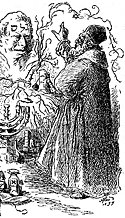The Golem Lives On
By Oren Lee-Parritz
 Most of us have forgotten about the Golem, having relegated it to the attic of children’s stories and fables in our mind. However, the concept of the Golem and its implications on society can be seen everywhere in our culture if you look close enough.
Most of us have forgotten about the Golem, having relegated it to the attic of children’s stories and fables in our mind. However, the concept of the Golem and its implications on society can be seen everywhere in our culture if you look close enough.
For those that are unfamiliar, the Golem was a creature created out of clay in order to protect the Jewish community in Prague against an anti-semitic emperor during the 16th century. According to the most popular account, the creator of the Golem was Rabbi Judah Loew the Maharal. The monster was endowed with super-human strength, but with no free will or concept of self. The method of animating the Golem depends on the version. It ranges from placement of the owner’s name written in blood on parchment in the Golem’s mouth to the inscription of “Emet” on its forehead (If you remove the first E or the Aleph, the word changess to “met” or death.)
The stories and versions of the fable are numerous but generally follow the premise. The Golem does its job well and protects the Jews but becomes too powerful at a certain point and threatens the lives of its creator, the Jewish community, or too many of the surrounding gentiles. This is a theme that we commonly see in many of our favorite western stories: beware of what you create. Though the story is one of mysticism, it also is a very good allegory for a collective fear of modernity and the horrors that we can create with our scientific knowledge.
Many examples can be seen in our popular culture if you look beyond the surface. How familiar does Mary Shelley’s Frankenstein sound? How about Bladerunner? While these are more straightforward examples, many other popular stories today are loosely based on the concept of a human creation that is too powerful. In both Terminator and the Matrix trilogies, the antagonists are computers that were originally designed to help humans with their artificial intelligence, but then became a little too smart and decided that humans were more of a nuisance than they were worth. Scientific hubris is not the only poignant issue addressed by this tale.
Another interesting interpretation is that it discusses our feelings in regards to the cost of security in the face of persecution. Society endows its guardians with power but becomes terrified when they are no longer under their control. This theme has come up time and time again in literature and popular culture. The Golem of pop culture can take the form of any number of robots, man made monsters, or even an overbearing police state. An interesting example of this is John Malkovich’s character in In the Line of Fire. His character is an ex-CIA agent that is determined to kill the president. When the protagonist, played by Clint Eastwood, asks him why he is so angry, he responds that he was turned into a monster to serve his country but the powers that be realized that they could not have “a beast roaming the countryside”.
In general, we create and modify living things or humanize machines in order to be used a tools. Such a pursuit is only moral so long as what is created is not suffering. The creation can only be presumed to not suffer if it is not alive or does not possess a consciousness. Our certainty of its inability to feel is what makes the creation useful for whatever dangerous or unpleasant task it may be designed for. However, given human fallacy, it is impossible for us to know if this is the case with out projects, regardless of how sure we may be. To create a consciousness requires that we be compassionate towards what we create, which often negates its utility.
Kay E. Vandergrift provides a few other abstract yet no less poignant interpretations of the Golem figure. Some have viewed the Golem as a metaphor for man’s transition into a machine-like being as a result of modernity. Others have looked at the Golem as a representation of the fact that humans often use violence as opposed to intelligence (the monster with immense strength but no brain) to solve their problems, often making them worse.
According to Joyce Ellen Weinstein of The Jewish Magazine: “Many people today say that although we can not create a golem on the level of Rabbi Yehuda Leow of Prague, still we have succeeded in creating a different form of golem. Rabbi Leow took a blob of earth, gave it form and introduced into it vitality, but with out intellectual abilities. Many say that our educational system has duplicated Rabbi Leow's feat, by taking intelligent children and turning out blobs.” [sic]
It is strange that the Jewish tradition has embraced the story of the Golem. Judaism has very strict commandments against graven images, not to mention statues. Mysticism and magic have not played a traditionally large role in Jewish Life, despite what the rise in popularity of faux-Kabballah among America’s celebrities may tell you. The combination of these two elements to form one of the most popular Jewish folktales is interesting indeed.
There exists a rumor that the remains of the Golem are interred in the Geniza of the Old-New Synagogue in Prague. A Nazi agent is purported to have died after entering the Geniza under suspicious circumstances. There is a large amount of literature on the Golem and many other versions of the story for those who are interested.
